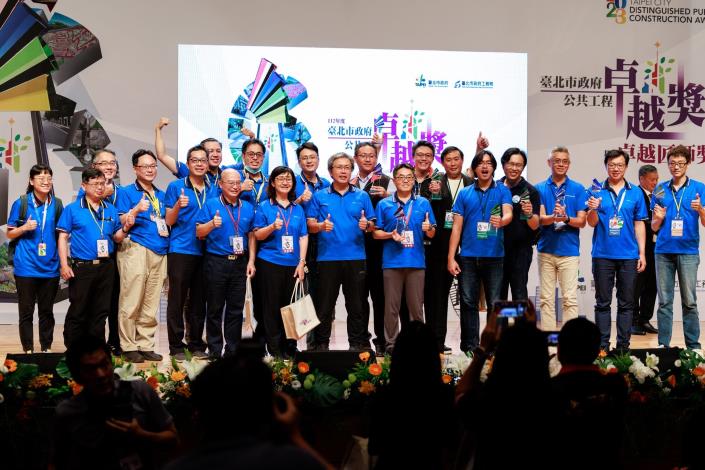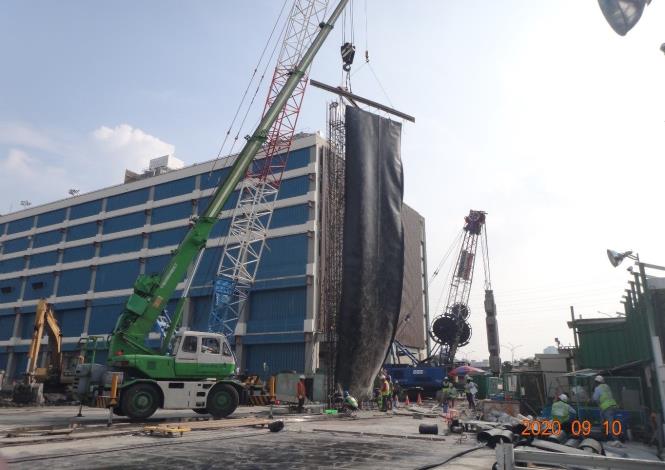HEO Recognized with 4 Major Awards During the Taipei City Government Distinguished Public Construction Awards Presentation Ceremony
Taipei City Government's highest honor in public construction, the Distinguished Public Construction Awards, was presented to winners in a grand ceremony today. The Hydraulics Engineering Office of the Public Works Department, Taipei City Government (HEO) nominated a total of four projects, including the “Improvement Project for Evacuation Gates and Adjacent Embankment Improvements of Tamsui River Gate 5,” the “Drainage Improvement Project for Lane 91, Section 1, Neihu Road,” the “Main Project for the Commissioned Reconstruction of Huannan Market under Taipei City Market Administration Office” and the “Replacement of Pump Units at Wanfang, Jingmei, and Qiyan Pumping Stations and Pump-Related Equipment at 3 Pumping Stations Including Pifu.” These projects were nominated for the Civil Engineering, Hydraulics Engineering, Architecture, and Facilities Excellence Awards categories. All four water-related projects from the HEO successfully passed rigorous evaluation processes, emerging as winners amidst intense competition in their respective categories. This achievement underscores the high praise given by the judges to the HEO's management capabilities and outstanding performance. According to the HEO, among the four winning projects, the civil engineering project titled “Improvement Project for Evacuation Gates and Adjacent Embankment Improvements of Tamsui River Gate 5” under the Civil Engineering category is situated at the intersection of Huanhe North Road and Minsheng West Road, a critical traffic artery in the city. Over the course of 8 months, from late August 2022 to the end of April 2023, the Dadaocheng Square underwent a remarkable transformation; unlike conventional embankment mural artworks, this beautification project incorporated various materials such as stainless steel, handcrafted artistic stonework, handcrafted art ceramics, fluoropolymer paint lightboxes, and projection lights in addition to painted murals. These materials were combined with inputs from public workshops to discuss how to soften the previously staid appearance of the embankment. In the past, when looking out from Dadaocheng Square, one could see the bustling scenes of the Dadaocheng commercial area. While strolling through the old district, the sight of sailboats navigating the Tamsui River was a common occurrence. However, due to the embankments that now separate the city and the river, direct views of the cityscape and the Tamsui River are obstructed. This beautification project aimed to achieve two goals: “Overlooking the city, introducing urban aesthetics” and “Overlooking the river while integrating the colors of Dadaocheng.” Additionally, LED projection lights were installed both inside and outside the embankment, not only enhancing the visual appeal of the embankment and square but also contributing to the safety of both pedestrians and drivers. The hydraulics engineering project titled “Drainage Improvement Project for Lane 91, Section 1, Neihu Road” in the Hydraulics category features the largest-diameter and longest rectangular box culvert with spiral wound lining in Taiwan. It introduced the latest spiral wound lining technology from overseas, overcoming the limitations of traditional open-cut construction methods and the inability to repair certain damaged sections. The project is aimed at reducing traffic disturbances, pipeline conflicts, and risks to neighboring areas, and presented a highly challenging task. Compared to traditional open-cut renewal projects, this initiative significantly shortened the construction period, minimized noise and air pollution, and reduced carbon emissions by 310 tCO2e, equivalent to the annual carbon sequestration capacity of the Daan Forest Park, with remarkable results. The project team adopted a non-excavation comprehensive renewal approach to simultaneously satisfy the structural and hydraulic performance of stormwater drainage, extending its service life and ensuring the security of life and property. In the Architecture category, the “Main Project for the Commissioned Reconstruction of Huannan Market under Taipei City Market Administration Office” is based on the Huannan Market, which was established in 1978 and served as a major wholesale market for fruits and vegetables, contributing around 30% of the total produce supply in the Greater Taipei area. Due to issues such as aging infrastructure, unhygienic surroundings, structural safety, and severe shortage of parking, the project aimed to revamp and renovate the market. Over the course of 18 years, the project underwent discussions, planning, and negotiations with market vendors. Construction commenced in 2016, and due to operating needs, it was divided into two phases. The first phase was completed and utilized as a temporary market, while the second phase was concurrently constructed to mitigate impact on commercial activities. To address various challenges, the project utilized advanced techniques, such as polyurea waterproofing for floor surfaces to meet user requirements, the installation of water-resistant exterior walls due to unique geological conditions, and the integration of central monitoring systems for electricity, air conditioning, lighting, sanitation, ventilation, fire prevention, security, and access control in the central control room. This achieved intelligent management, energy conservation, and safety disaster prevention. After completion, the new market is set to provide 1,332 stalls, 9 large truck unloading spaces, 56 small truck unloading spaces, 1,720 small vehicle parking spaces, 1,433 motorcycle parking spaces, spaces for community activities, and office spaces. The project obtained the Silver Grade Green Building and Bronze Grade Smart Building Candidate Certificates, aiming to create a better operating and shopping environment. Lastly, in the Facilities category, the “Replacement of Pump Units at Wanfang, Jingmei, and Qiyan Pumping Stations and Pump-Related Equipment at 3 Pumping Stations Including Pifu” Project was initiated because the aging pump units at the Wanfang, Jingmei (old), and Qiyan pumping stations have been in use for over 25 years, leading to issues such as smoke pollution and noise. In the case of the Wanfang Pumping Station, four 5CMS (cubic meters per second) pump units were replaced with new units of 6CMS capacity, increasing the total pumping capacity from 20 cubic meters per second to 24 cubic meters per second, significantly enhancing the pumping volume and meeting planned drainage needs. At the Jingmei Pumping Station, two 4CMS pump units, aside from the clutch, have been in use for 37 years. Although still serviceable, they were replaced to ensure reliability. At the Qiyan Pumping Station, four 3CMS pump units were replaced with new units of 3.5CMS capacity, raising the total pumping capacity from 20 cubic meters per second to 24 cubic meters per second. Furthermore, the project takes into consideration the drainage needs in the Wenlin drainage basin, which mainly covers the Beitou Shilin Technology Park with Chengde Road as its eastern boundary, including areas east of Chengde Road, west of Wenlin North Road and the Huang River, and north of Shuangxi, including Wenlin Elementary School and Zhongzheng Senior High School, and taking into account the relative lower elevation of the drainage requirements in this area, as well as the rainfall capacity assessment based on an estimated rain intensity of 88.8 mm/hr. The project encompasses the future expansion of the Wenlin Pumping Station with two 2.1CMS pump units to meet the pumping capacity requirements in various areas. The HEO emphasized that these four projects not only adopt unique construction techniques to achieve time and labor savings but also incorporated energy-saving, carbon reduction, and long-term sustainability considerations. The HEO will continue to refine public construction and planning, upholding a commitment to high standards and demanding requirements for public infrastructure quality, and strive for more honors and achievements in the future.




![Taiwan.gov.tw [ open a new window]](/images/egov.png)
